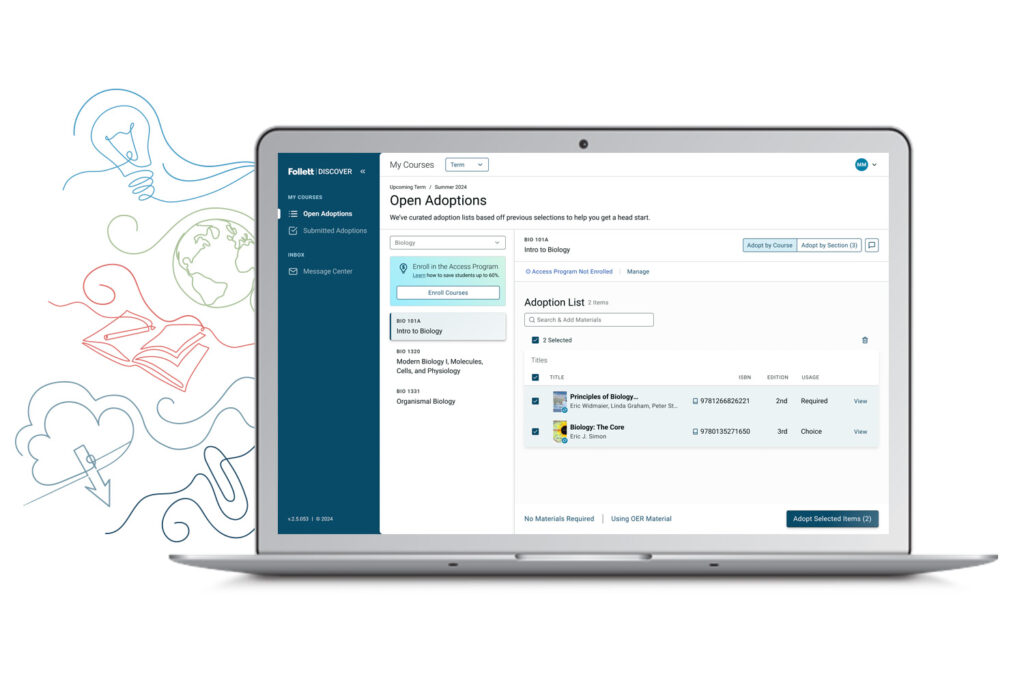
Supporting Faculty Adoptions: A User-Driven Approach
How Follett’s Product Team Launched a Research Roadtrip to Evolve the Faculty Adoption Experience
By Chrissy Cowdrey, Director of UX, Follett Higher Education
What Makes a Great Adoption Platform?
From designing and teaching courses, to conducting research, to mentoring students, faculty have a lot to manage. In the course of single term, they manage a huge volume of individual tasks across an increasing number of software platforms. One of those platforms, the course material adoptions tool, has a direct link to student affordability and success. For faculty, it’s important that adopting course materials is quick and intuitive, so they can get adoptions in on time and move on to the good stuff: teaching! Plus, on time adoptions mean that Follett is positioned to source the course materials at the lowest possible price—so students can save.
A great course material adoption platform needs to smooth out the complexities of the course material process, so when a faculty member is ready to adopt materials, the experience feels consistent, user-friendly, and—most of all—easy.
As part of our commitment to supporting every step of the academic journey, we knew we had an opportunity to reimagine our faculty adoption experience to ensure our tool meets the evolving needs of faculty and department admins. The best way to do that was to go straight to the source—hearing directly from our campus partners!
Getting User Feedback: A Research Roadtrip
In November 2023, my team members on the Follett product team kicked off a project to get up-to-date, specific faculty and administrator feedback on how they use the our adoption tool. In collaboration with our engineering and and user experience (UX) design teams, we launched a two-week research study with a core group of schools including Baylor, Old Dominion University, Texas State, and more—and started visiting campuses.
We spent time talking face-to-face with faculty who managed their own adoptions, as well as administrators who managed large adoptions on behalf of a department. All in all, the research program included:
- 8 participants (a mix of faculty and administrators)
- 5 universities
- 20 hours of interviews
We wanted to learn what real users thought about Follett’s adoption tool. Particularly:
- What were their challenges?
- What stood in their way of submitting course material adoptions?
- How often did they choose new material?
- How did pricing impact their choices?
We spent time with each participant getting a close-up view of how they submit and coordinate adoptions. We asked them to show us any tools, both digital and analog, that they might use in the process. We wanted to understand how they think through their course material adoption process and the barriers they encounter along the way.

A Path Forward: Experience Maps and A New Prototype
Based on this feedback, our team created experience maps that charted how each person interacted with the Follett adoption tool—which helped us identify pain points and opportunities for solving them. We then synthesized our user research into actionable insights; these insights serve as our “north stars” as we continue to evolve and improve the adoption experience. Here’s just one example insight from our research, with a recommendation for a product enhancement to meet this need:
- Sample Insight : Faculty aim to balance cost and quality in course materials, prioritizing affordable, high-quality options with lasting educational value for students:
- Sample Conclusion: We should design an experience that provides clear context on pricing, alongside quality metrics, to support informed and consistent decision-making regarding course materials.
The team’s next step was to take these experience maps, as well as the various user stories we gathered from our work “in the field,” and begin to propose design principles: the guidelines have informed a new, modern look-and-feel for the platform.

The team built a prototype for this upgraded tool, focused on ease, simplicity and reducing noise. It was important that we create an experience that allowed admins or faculty to stay laser-focused on their task. Our research didn’t stop after that first prototype. It continued up until the moment we finalized the new experience. We went back to our participants to further test and learn to ensure we were heading in the right direction.
__
“I love that it makes it much easier to see what you’ve done, and what you’ve got to do…it just seems more clear.” – Holly E. Woods, Coordinator at University of Texas at Arlington
__
New functionality available in the coming weeks includes adoption reminders and making it easier for users to re-adopt previously-used materials. The image at the right shows a preview of the kinds of emails faculty will receive to make adoptions quick and convenient.

As the product continues to land in front of more customers, more learnings will start to surface. We want to know what’s working, what’s still missing: in our mind, product design is never complete. We’re excited to continue this focus on user-driven insights as we work to improve our products and technology across the Follett ecosystem.
__
For Fall 2024, all faculty and admins at Follett schools using the adoption tool will see:
- A one-click re-adopt experience.
- A cleaner, modern interface, to reduce the amount of time spent submitting adoptions.
- More transparency in terms of price, format selection, and affordable Access titles.
Thanks to the schools, faculty, and admins who participated in our research study! We look forward to bringing you more innovations that inspire, enable, and celebrate all elements of the academic journey.